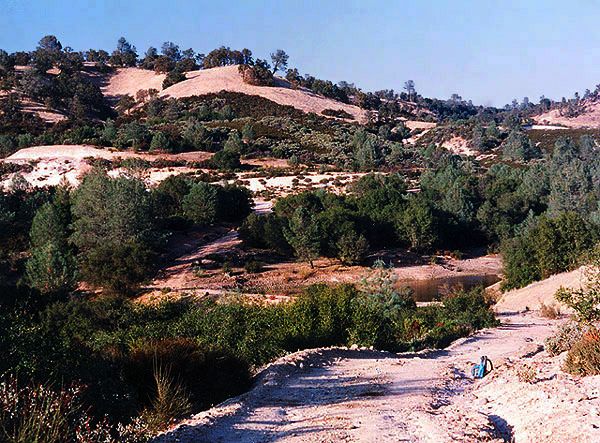
|
Here is a late afternoon view to the Discovery Site in the Ione Basin, Amador County, California--the specific locality, marked by the blue backpack at lower right, where I first found fossil plants in the Middle Eocene Ione Formation. This is pretty high up in the local Ione Formation geologic section. Take a look at the pale-brown brush covered slopes along the skyline. The overlying Upper Oligocene to Lower Miocene Valley Springs Formation begins at the dramatic, distinctive vegetation break along that hillside in the distance--the exact geologic contact between the Valley Springs above and the Ione Formation below lies at the obvious break between the green manzanita brush below and the pale-brown, grass-covered, tree-studded slope above; rocks above the patch of green manzanita, to the skyline, belong to the Valley Springs Formation. This is one of the most famous geologic contacts in all of northern California. It records a dramatic change in paleoclimates, from a humid, subtropical regime of active physical and chemical weathering during Ione times (probably much like the climate of present-day southern Florida in the southeastern United States, for example), to a much drier and cooler climate punctuated, locally in the ancestral Ione Basin some 21 million years ago, by periodic rhyolitic volcanic eruptions during deposition of the overlying Valley Springs Formation. I discovered this site on July 21, 1991, during a visit to the western foothills of the Sierra Nevada to fossil-prospect for leaves in the Upper Miocene Mehrten Formation. Several months earlier, I'd collected fossil plants from a "forgotten," classic locality in the Mehrten near Colombia State Park (contracted a devastating case of poison oak dermatitis in the process, by the way...). And I was already familiar with several famous leaf localities from the so-called chocolate shale horizons of the Eocene auriferous gravels higher up the slopes of the Sierran foothills, in the vicinity of Grass V alley/Nevada City--beautifully preserved leaves found in amazing abundance at several of the abandoned, open pit hydraulic gold mines--sites no longer accessible to unauthorized amateur explorations, by the way. Each of the fossil-bearing hydraulic pits lies on private property, within a Federal National Forest; collecting is no longer allowed there without written permission from the landowners, or a special use permit issued by the US Forest Service. When I came across some well-exposed, promising sandstones and shales in the Ione Basin of Amador County, California, that day in July, 1991, I was working on the initial assumption that I was dealing with strata that could be assigned to the Upper Miocene Mehrten Formation. I had Merhten Formation "on the brain," as it were. I have since learned that all the fossil plants, ichnofossils and montan-wax-bearing lignites I've collected in the Ione Basin derive from the Middle Eocene Ione Formation. But, this paleobotanical and geological understanding was apparently rather difficult to pound into my head. When I finally came to the realization that the fossils were not from the Mehrten, I latched on to the idea that they must be from the Lower Miocene Valley Springs Formation. Wrong again, of course. At some point I eventually became convinced that I was dealing with the Middle Eocene Ione Formation--not the Mehrten or even the Valley Springs. It was hard-won knowledge, to be certain. Here is a quote from my field notebook, dated July 21, 1991: "7/21/91--12:45pm.--Sunday: Just returned from another classic, immediately legendary excursion/fossil-find: I discovered fossil leaves in the Upper Miocene Mehrten Formation. More later. Will lunch now. Back at 3:48pm: Arrived at the locality shortly after 10:00am--spent a little over an hour fossil prospecting. This is another one of those remarkable trips. I had only dreamed of locating fossil leaves in the continental Mehrten Formation, a deposit that includes coarse cobble conglomerates, sandstones, ashes, tuffs, fine-grained clays and in various areas beds of lignite." That quote commemorates my initial day of discovery in the Ione Basin. But, it was only the beginning. For several successive years, primarily in the 1990s, I made occasional exploratory visits to the Ione Basin in search of additional fossil leaf localities. And I was quite successful in my fossil searchings. As I continued to amass quite a personal collection of roughly 45 million-year-old specimens from the Middle Eocene Ione Formation, my "fossil shed" began to burst with specimens--I had the shed literally packed to the rafters with boxes loaded with Ione leaf remains. Also, on occasion, I wrote to paleobotanist Howard Schorn (retired Collections Manager Of Fossil Plants at the University California Museum Of Paleontology in Berkeley), keeping the scientist apprised of my discoveries. Eventually, I decided to donate all of my specimens from the Ione Basin to science. So, in the Fall of 1998 I contacted the University California Museum Of Paleontology in Berkeley to make arrangements for the transfer; and in late 1998 my father and I loaded up the enormous, extensive collection in a U-Haul van and motored to Berkeley to present to Dr. Diane Erwin, Collections Manager Of Fossil Plants at the museum, the scores of boxes of fossil plants--not only from the Eocene Ione Formation, Ione Basin, California, but also from numerous other paleobotanical sites in California, Nevada and Idaho. Along with the innumerable paleobotanical specimens, I also submitted to Dr. Erwin at the UC Berkeley museum all of my detailed locality data. To the best of my knowledge, those specimens from the Middle Eocene Ione Formation were the very first Eocene fossil plants ever placed in a museum from the Ione Basin. Please note: All fossil localities in the Ione Formation of Amador County, California, presently occur on private property; explicit permission from the land owners must be secured before collecting fossils there. |